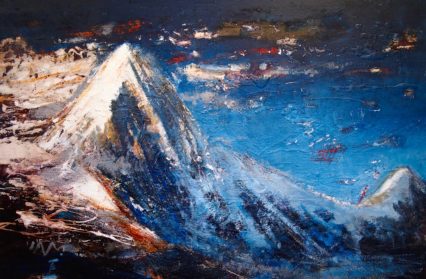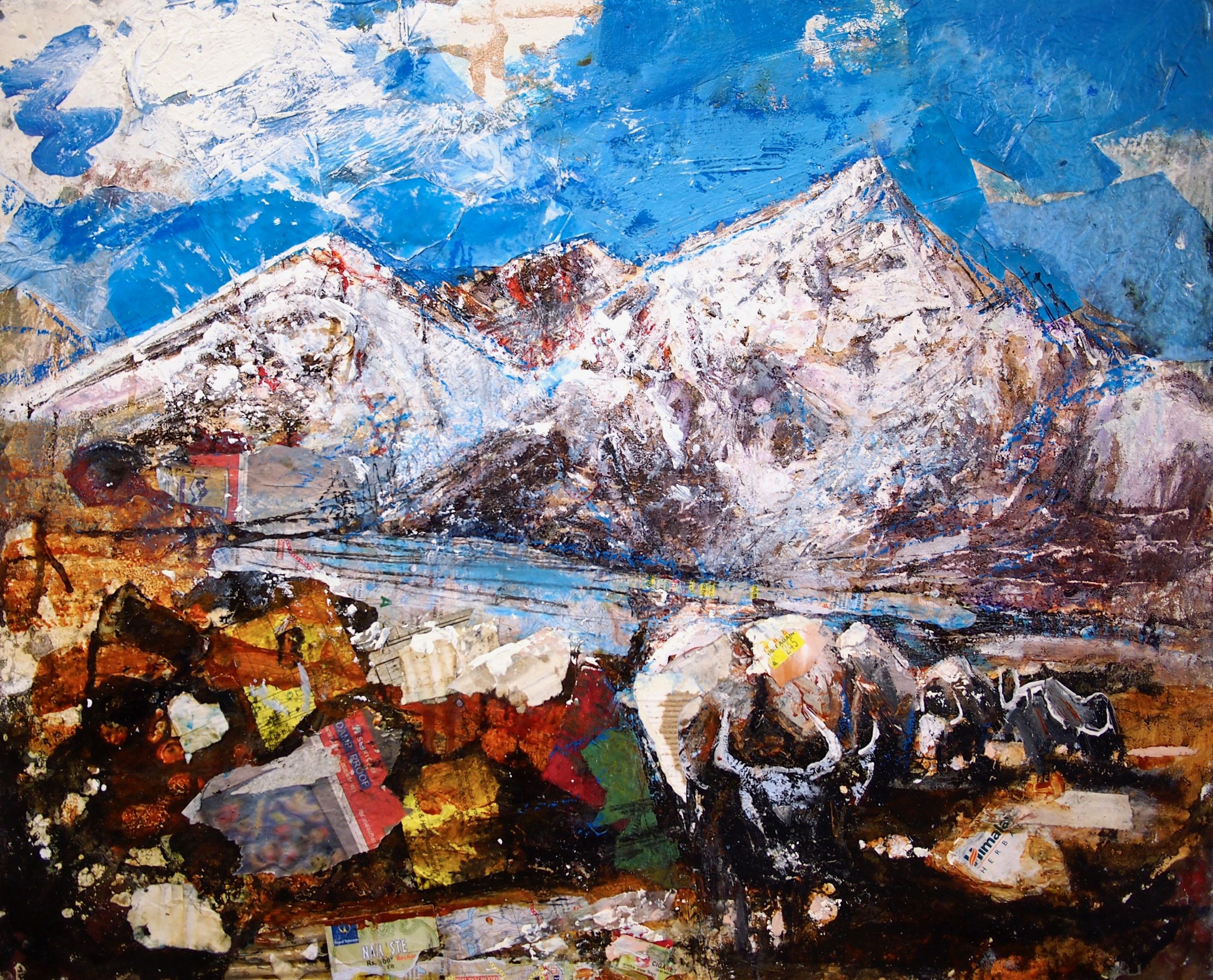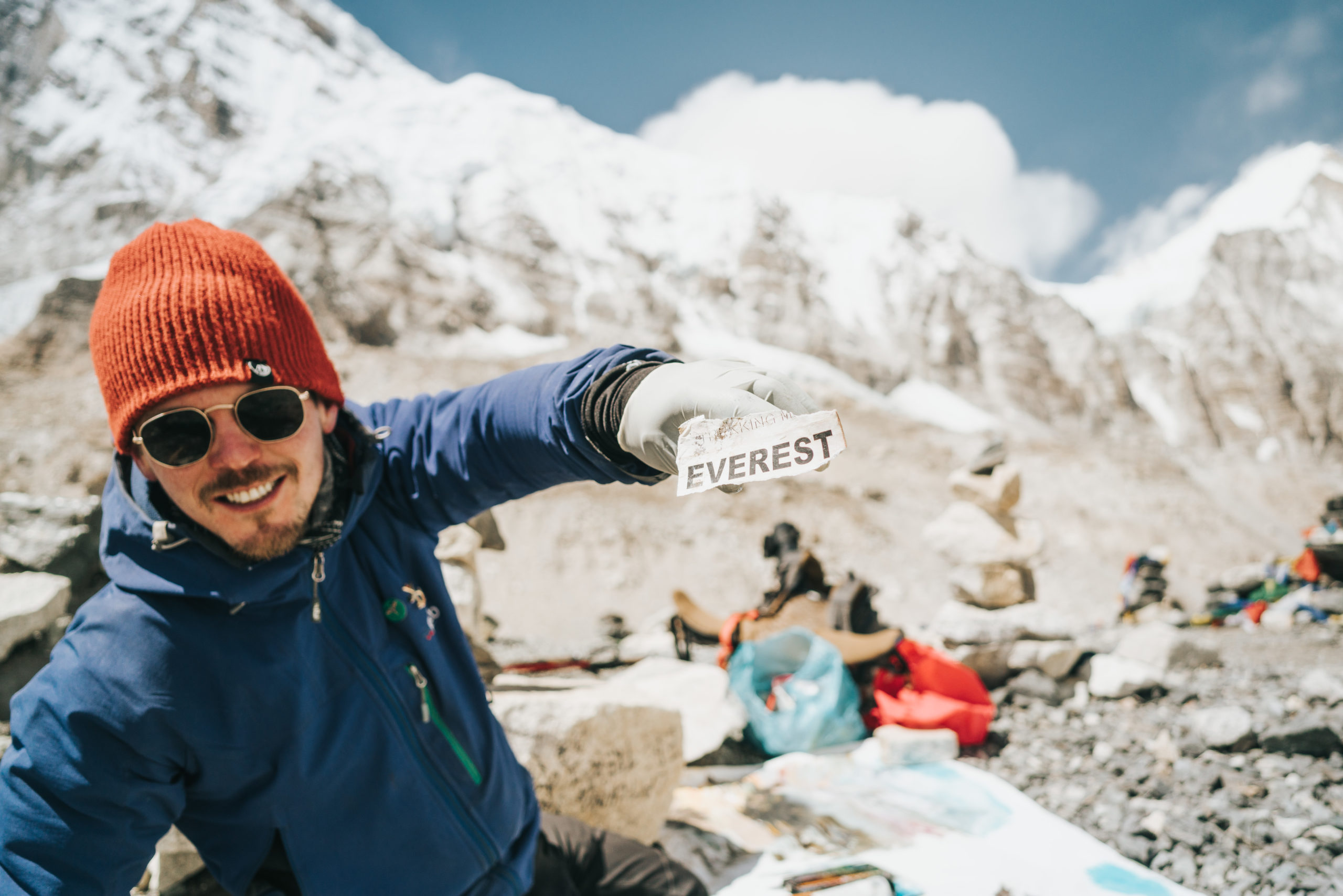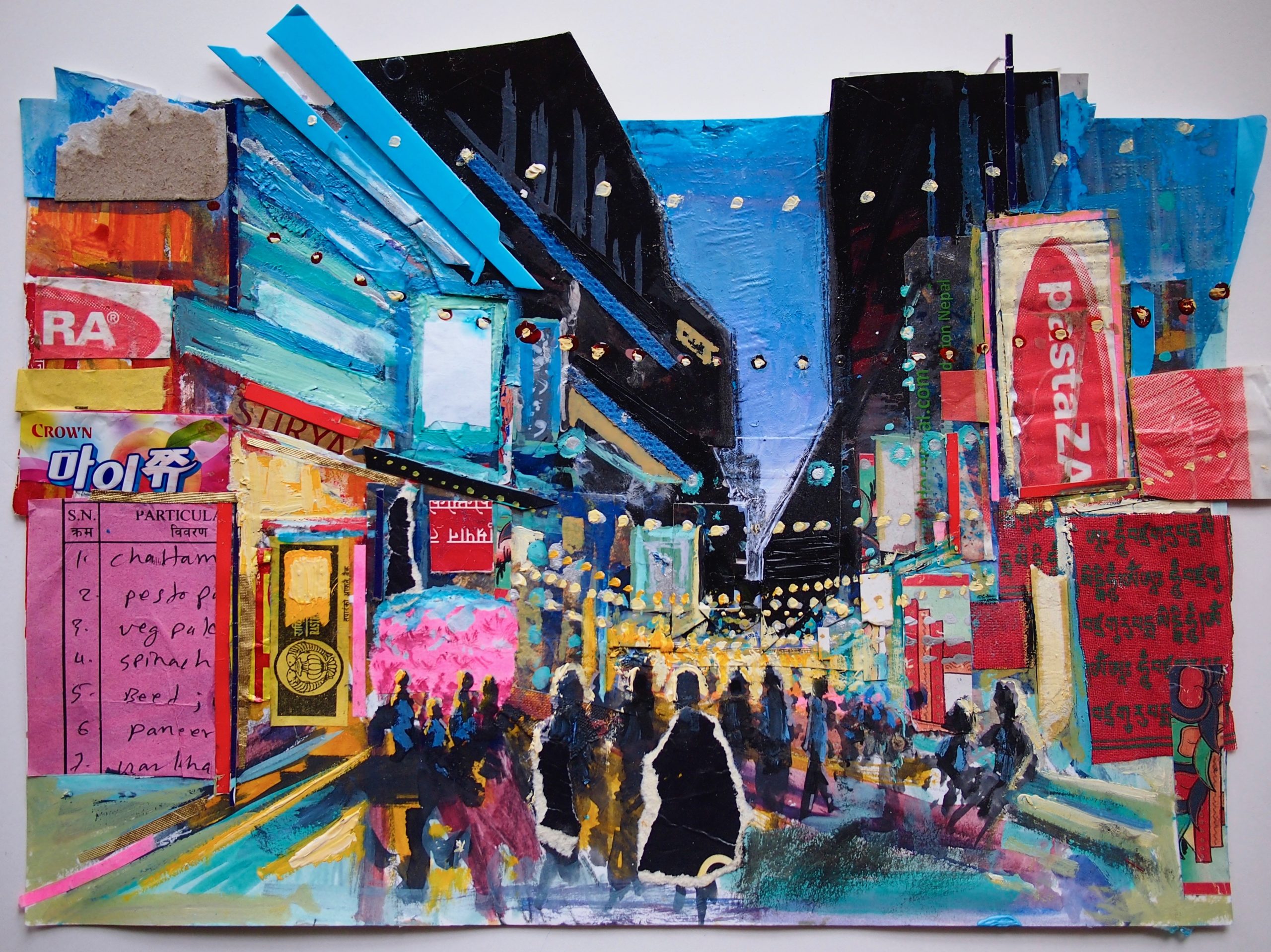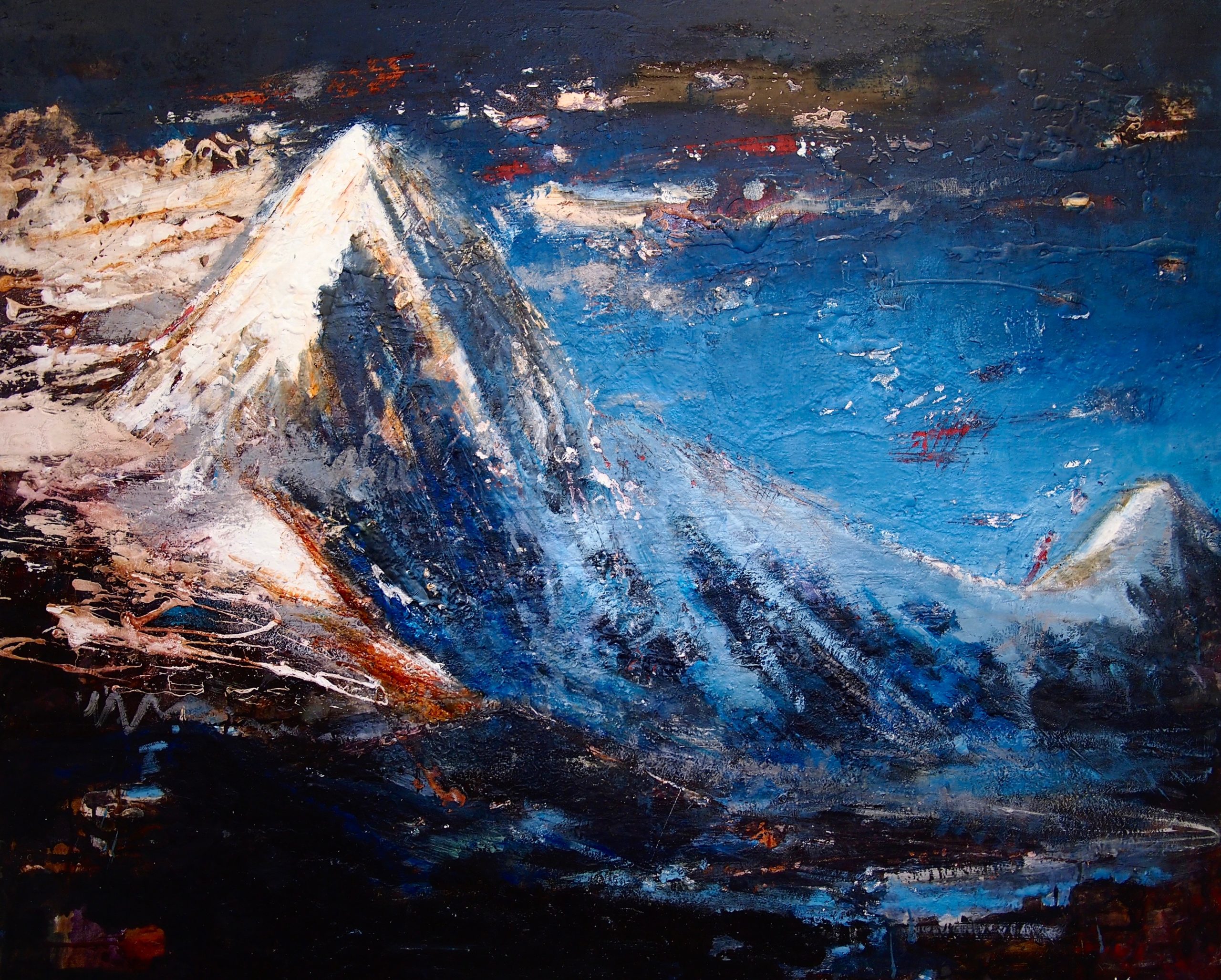Artist Peter Kettle has created an extraordinary collection of artwork from rubbish he helped clear during a gruelling expedition to Everest Basecamp. Here, the Bristol-based artist describes the arduous 14-day trek.
The motive:
Over the past decade, extraordinary efforts have been made to free Everest Basecamp of waste. The Sherpa community, charities and Nepalese government – working in the wake of the 2015 Earthquake – have collaborated in keeping the area clean. However, wider reaches of the Himalayas still see areas of environmental concern. The purpose of this expedition was to try and help with the collection of litter, however small, but also to highlight the growing concerns in this particular environmental issue, documenting our challenge through painting and film.
We wanted to bring back a series of work celebrating one of the most revered mountaineering treks in the world, and promote the continued work in maintaining an area of natural beauty. It was certainly beautiful. We discovered the litter was not extensive, but there was enough to fill a few bags every two to three days trekking. An enormous effort was made in 2016 – 2017 to clear the rubbish, old camping gear, and even the remains of fallen hikers on the route to the summit of Everest from Basecamp. However, the rest of the Himalayas outside of Basecamp Everest still needs attention and measures put in place to prevent further pollution, fly-tipping and general litter waste.
The Trek:
It took place in March 2019 and along the 14-day trek, to and from Basecamp, we endured all of what this challenge set out to be – a sometimes painful, but mostly enthralling journey to the tallest mountain in the world. We prepared ourselves for altitude sickness, in Kathmandu bought and packed our goose down jackets and played Tetris with our supplies and hiking equipment. From Lukla, we hired and met our Sherpa guide ‘Babu’; and as a trio, took our pace easy.
Averaging five to seven hours hiking a day, we meandered up the lush green valleys, stopping off at villages to take stock, giving room to Yaks and Donkeys taking supplies to Everest and back. Some training before arriving in Nepal helped, but sporadic inclines did sometimes take its toll carrying 18 kilos of art and hiking equipment each. However, each night’s rest brought new stamina for the day ahead. The green Nepalese valleys became ochre hillsides, and eventually granite grey scree and glacial valleys with icy peaks. As the temperature dropped to -25 degrees, we began to wear our luggage.
Arriving at Basecamp:
In some ways, it felt very much like a pilgrimage towards the world’s tallest cathedral, Mt. Everest. At the end of each weary day, we knew we would eventually be meeting something majestic. At 70% oxygen, fatigued and with a biting cold wind, it was difficult to find words for arriving at the foot of Everest. Firstly, camaraderie with the those we walked, drank and ate with; sharing stories with locals and visitors from all over the world; plodding along and listening. Watching each person reach the summit of Kala Pattar at 5643m (the viewpoint looks down onto Basecamp), put asunder with altitude sickness and tiredness, but reaching their goal was inspiring. But mainly the feeling was awe, with an underbelly of relief and a total sense of escape. It was beautiful, but that beauty was a collection of all the moments getting there. If you dropped us off in a helicopter at Basecamp and showed us Basecamp, it would look like a large scoop of ice sitting beneath an eroded black rock. But after 10 days eating, sleeping and dreaming of Everest Basecamp, it became a rite of passage to something bigger; shared with others.
‘Another Man’s Treasure’ – the Sketches:
Sketching and painting the trek to Basecamp became a process of discovery with every piece of litter collected. Initially, it began as an expedition to paint en plein air paintings on large canvas and contribute in a small way to collecting refuse en route. However, using the litter into collage paintings was a very novel approach for me. ‘Another man’s treasure’ comes to mind. Having never tried this before, I found myself loving the process of spotting textures and colours within the materials collected in: newspapers, sweet wrappers, Lodge receipts, plastic bags, discarded maps, cardboard, cigarette packets, rice sacks and torn prayer flags. They all brought their unique aesthetic to the work. It felt intimate and documentary. I found further narratives developing within each piece made, and compelled to create a series along the route.
The Studio Pieces back in Bristol:
Back in my studio in Bristol, using the field studies and en plein air paintings on canvas, I spent seven months creating larger impressions and abstracts of the collage series on to canvas. I felt a new approach taking on in the studio with this project; playing with colour, textures and incorporating further materials collected from Nepal, back into the studio paintings. I’ve always worked with layers, but this approach using Collage with Oils, Watercolour Inks, Shellac and Acrylics became more sculptural than painterly, and more tangible and interpretive. I referenced the sketches, but mainly used my memories, and part imagination, to create the abstract pieces. I referred only every so often to photographs and sketches, opting for a freer approach over the representational style of the field studies. But seeing the paintings and collage works juxtaposed together, encompasses a lot of what I wanted to achieve in this exhibition, something expressive and documentary.
Peter Kettle’ Basecamp exhibition takes place from Thursday, March 12 to Saturday, April 4. (Running alongside Peter’s exhibition is a collection of selected works from a small group of emerging Welsh artists, titled Young at Art. Rhys Aneurin, Sarah Louise Davies, Tegerin Roberts, Geraint Ross Evans and Lara Smith will exhibit paintings and drawings. There will also be bronzes from Llŷr Erddyn Davies and jewellery from Mati Roberts. Visitors to the gallery might recognise some local sights, with a painting of the capital’s Boulevard de Nantes by Lara Smith and Caswell Bay by Sarah Louise Davies. There is also a modernistic take on a building in Cardiff’s Cathedral Road by Rhys Aneurin and one of Maenofferen Quarry by Tegerin Roberts.)
Details:
The Albany Gallery, 74b Albany Road, Cardiff, CF24 3RS
Tel: 029 2048 7158


